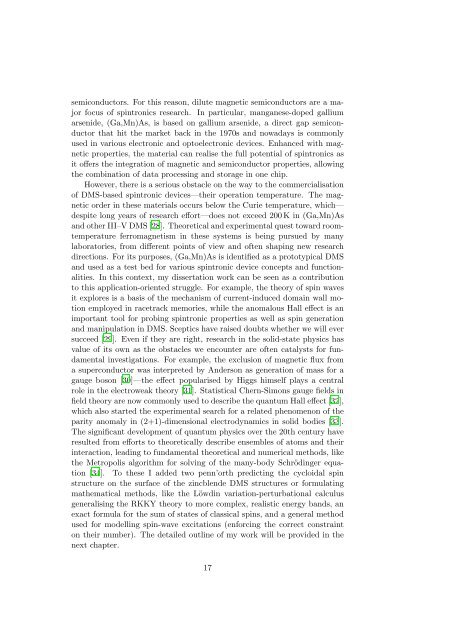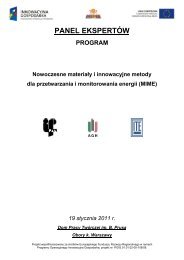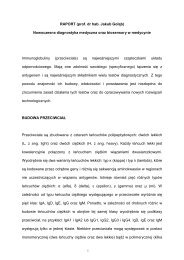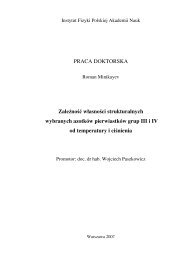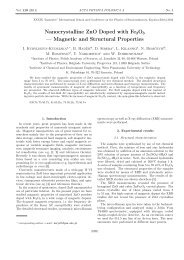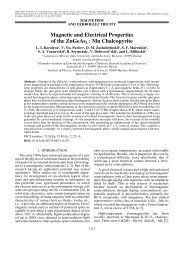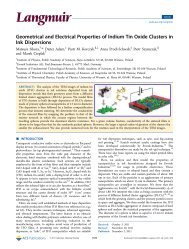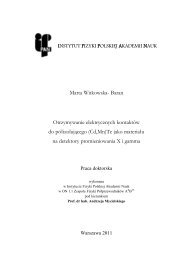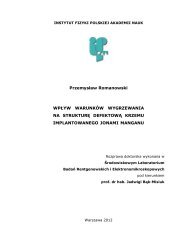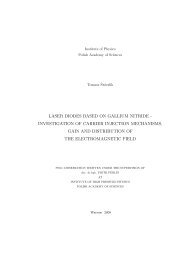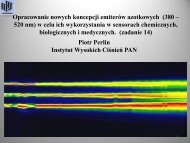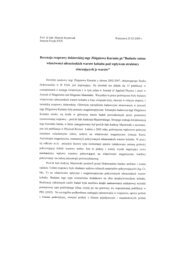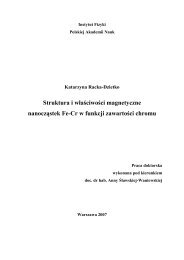Spin waves and the anomalous Hall effect in ferromagnetic (Ga,Mn)As
Spin waves and the anomalous Hall effect in ferromagnetic (Ga,Mn)As
Spin waves and the anomalous Hall effect in ferromagnetic (Ga,Mn)As
You also want an ePaper? Increase the reach of your titles
YUMPU automatically turns print PDFs into web optimized ePapers that Google loves.
semiconductors. For this reason, dilute magnetic semiconductors are a majorfocus of sp<strong>in</strong>tronics research. In particular, manganese-doped galliumarsenide, (<strong>Ga</strong>,<strong>Mn</strong>)<strong>As</strong>, is based on gallium arsenide, a direct gap semiconductorthat hit <strong>the</strong> market back <strong>in</strong> <strong>the</strong> 1970s <strong>and</strong> nowadays is commonlyused <strong>in</strong> various electronic <strong>and</strong> optoelectronic devices. Enhanced with magneticproperties, <strong>the</strong> material can realise <strong>the</strong> full potential of sp<strong>in</strong>tronics asit offers <strong>the</strong> <strong>in</strong>tegration of magnetic <strong>and</strong> semiconductor properties, allow<strong>in</strong>g<strong>the</strong> comb<strong>in</strong>ation of data process<strong>in</strong>g <strong>and</strong> storage <strong>in</strong> one chip.However, <strong>the</strong>re is a serious obstacle on <strong>the</strong> way to <strong>the</strong> commercialisationof DMS-based sp<strong>in</strong>tronic devices—<strong>the</strong>ir operation temperature. The magneticorder <strong>in</strong> <strong>the</strong>se materials occurs below <strong>the</strong> Curie temperature, which—despite long years of research effort—does not exceed 200K <strong>in</strong> (<strong>Ga</strong>,<strong>Mn</strong>)<strong>As</strong><strong>and</strong>o<strong>the</strong>rIII–VDMS[28]. Theoretical<strong>and</strong>experimentalquesttowardroomtemperatureferromagnetism <strong>in</strong> <strong>the</strong>se systems is be<strong>in</strong>g pursued by manylaboratories, from different po<strong>in</strong>ts of view <strong>and</strong> often shap<strong>in</strong>g new researchdirections. For its purposes, (<strong>Ga</strong>,<strong>Mn</strong>)<strong>As</strong> is identified as a prototypical DMS<strong>and</strong> used as a test bed for various sp<strong>in</strong>tronic device concepts <strong>and</strong> functionalities.In this context, my dissertation work can be seen as a contributionto this application-oriented struggle. For example, <strong>the</strong> <strong>the</strong>ory of sp<strong>in</strong> <strong>waves</strong>it explores is a basis of <strong>the</strong> mechanism of current-<strong>in</strong>duced doma<strong>in</strong> wall motionemployed <strong>in</strong> racetrack memories, while <strong>the</strong> <strong>anomalous</strong> <strong>Hall</strong> <strong>effect</strong> is animportant tool for prob<strong>in</strong>g sp<strong>in</strong>tronic properties as well as sp<strong>in</strong> generation<strong>and</strong> manipulation <strong>in</strong> DMS. Sceptics have raised doubts whe<strong>the</strong>r we will eversucceed [29]. Even if <strong>the</strong>y are right, research <strong>in</strong> <strong>the</strong> solid-state physics hasvalue of its own as <strong>the</strong> obstacles we encounter are often catalysts for fundamental<strong>in</strong>vestigations. For example, <strong>the</strong> exclusion of magnetic flux froma superconductor was <strong>in</strong>terpreted by Anderson as generation of mass for agauge boson [30]—<strong>the</strong> <strong>effect</strong> popularised by Higgs himself plays a centralrole <strong>in</strong> <strong>the</strong> electroweak <strong>the</strong>ory [31]. Statistical Chern-Simons gauge fields <strong>in</strong>field <strong>the</strong>ory are now commonly used to describe <strong>the</strong> quantum <strong>Hall</strong> <strong>effect</strong> [32],which also started <strong>the</strong> experimental search for a related phenomenon of <strong>the</strong>parity anomaly <strong>in</strong> (2+1)-dimensional electrodynamics <strong>in</strong> solid bodies [33].The significant development of quantum physics over <strong>the</strong> 20th century haveresulted from efforts to <strong>the</strong>oretically describe ensembles of atoms <strong>and</strong> <strong>the</strong>ir<strong>in</strong>teraction, lead<strong>in</strong>g to fundamental <strong>the</strong>oretical <strong>and</strong> numerical methods, like<strong>the</strong> Metropolis algorithm for solv<strong>in</strong>g of <strong>the</strong> many-body Schröd<strong>in</strong>ger equation[34]. To <strong>the</strong>se I added two penn’orth predict<strong>in</strong>g <strong>the</strong> cycloidal sp<strong>in</strong>structure on <strong>the</strong> surface of <strong>the</strong> z<strong>in</strong>cblende DMS structures or formulat<strong>in</strong>gma<strong>the</strong>matical methods, like <strong>the</strong> Löwd<strong>in</strong> variation-perturbational calculusgeneralis<strong>in</strong>g <strong>the</strong> RKKY <strong>the</strong>ory to more complex, realistic energy b<strong>and</strong>s, anexact formula for <strong>the</strong> sum of states of classical sp<strong>in</strong>s, <strong>and</strong> a general methodused for modell<strong>in</strong>g sp<strong>in</strong>-wave excitations (enforc<strong>in</strong>g <strong>the</strong> correct constra<strong>in</strong>ton <strong>the</strong>ir number). The detailed outl<strong>in</strong>e of my work will be provided <strong>in</strong> <strong>the</strong>next chapter.17


